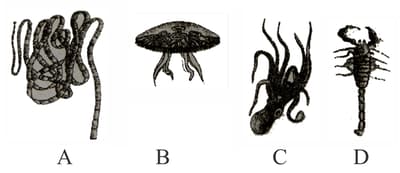MEDIUM
NEET
IMPORTANT
Earn 100
How do you differentiate a butterfly from a moth?
(a)Moth has feathery antennae but the butterfly has club-shaped antennae
(b)Moth has one pair of wings, but the butterfly has two pairs of wings
(c)The moth is diurnal, but the butterfly is nocturnal
(d)Moth has simple eyes, but the butterfly has compound eyes
18.75% studentsanswered this correctly

Important Questions on Animal Kingdom
MEDIUM
NEET
IMPORTANT
What is true about Nereis, scorpions, cockroaches, and silverfish?
MEDIUM
NEET
IMPORTANT
Identify the figures A, B, C and D given below and select the correct option.

MEDIUM
NEET
IMPORTANT
Read the following statements and select the incorrect ones.
(i) Circulatory system in arthropods is of closed type.
(ii) Parapodia in annelids help in swimming.
(iii) Phylum Mollusca is the second largest animal phylum.
(iv) Aschelminthes are dioecious.
EASY
NEET
IMPORTANT
The given figures (A - D) show four animals. Select the correct option with respect to a common characteristic of any two of these animals.

EASY
NEET
IMPORTANT
Which one of the following statements about certain given animals is correct?
EASY
NEET
IMPORTANT
Phylum Mollusca can be distinguished from other invertebrates by the presence of _____.
MEDIUM
NEET
IMPORTANT
Fill up the blank spaces in the table below by selecting the correct option.
| Phylum/Class | Excretory organ | Circulatory system | Respiratory organ |
|---|---|---|---|
| Arthropoda | A | B | Lungs/Gills/ Tracheal system |
| C | Nephridia | Closed | Skin |
| D | Metanephridia | Open | E |
| A | B | C | D | E | |
|---|---|---|---|---|---|
| (i) | Green gland | Closed | Mollusca | Annelida | Tracheal system |
| (ii) | Malpighian tubule |
Open | Annelida | Mollusca | Feather-like gills |
| (iii) | Antennary gland |
Open | Porifera | Amphibia | Lungs |
| (iv) | Nephridia | Closed | Mollusca | Annelida | Lungs |
MEDIUM
NEET
IMPORTANT
Which one of the following is a matching set of a phylum and its three examples?
A B (i) Porifera Spongilla, Euplectella, Pennatula (ii) Cnidaria Dentalium, Physalia, Aurelia (iii) Platyhelminthes Planaria, Schistosoma, Enterobius (iv) Mollusca Loligo, Teredo, Octopus
